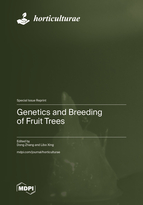Genetics and Breeding of Fruit Trees
A special issue of Horticulturae (ISSN 2311-7524). This special issue belongs to the section "Genetics, Genomics, Breeding, and Biotechnology (G2B2)".
Deadline for manuscript submissions: closed (31 May 2022) | Viewed by 27469
Special Issue Editors
Interests: plant molecular biology; plant biotechnology
Special Issues, Collections and Topics in MDPI journals
Interests: developmental biology of fruit trees; regulation of flowering induction
Special Issue Information
Dear Colleagues,
Among the plant-based products, wild fruits were a primary source of food for humans prior to agricultural civilization. At present, fruits possess a great deal of importance in a balanced diet and fruit trees are planted as commercial crops worldwide. Fruits have changed dramatically in many traits (e.g., shape, color, taste, aroma, tree form, and environmental adaptation) compared to their wild ancestors, with a long period of intensive domestication and breeding practice. The genetic research and conventional breeding of fruit trees have long been hampered by their perennial nature, long juvenile phase and generation time, large plant size, and high heterozygosity. Encouragingly, recent advancements in genomic analysis and molecular biotechnology have greatly promoted genetic research and accelerated the breeding process of fruit trees. The trends for fruit breeding in the future include diversified cultivars to meet different demands of consumers and processing, better resistance to environmental stresses, and a less labor-intensive culture practice.
This Special Issue of Horticulturae will present a comprehensive overview of the most interesting and significant research on the genetics and breeding of fruit trees. We cordially invite researchers to submit articles to this Issue focusing on the following fields of fruit research: collection and evaluation of germplasm resources, functional gene mining and exploration, theoretical methods and technologies of breeding, new variety breeding, and vegetative propagation. Reviews providing a summary of past works around this theme and forward-looking perspectives will also be appreciated.
Prof. Dr. Dong Zhang
Dr. Libo Xing
Guest Editors
Manuscript Submission Information
Manuscripts should be submitted online at www.mdpi.com by registering and logging in to this website. Once you are registered, click here to go to the submission form. Manuscripts can be submitted until the deadline. All submissions that pass pre-check are peer-reviewed. Accepted papers will be published continuously in the journal (as soon as accepted) and will be listed together on the special issue website. Research articles, review articles as well as short communications are invited. For planned papers, a title and short abstract (about 100 words) can be sent to the Editorial Office for announcement on this website.
Submitted manuscripts should not have been published previously, nor be under consideration for publication elsewhere (except conference proceedings papers). All manuscripts are thoroughly refereed through a single-blind peer-review process. A guide for authors and other relevant information for submission of manuscripts is available on the Instructions for Authors page. Horticulturae is an international peer-reviewed open access monthly journal published by MDPI.
Please visit the Instructions for Authors page before submitting a manuscript. The Article Processing Charge (APC) for publication in this open access journal is 2200 CHF (Swiss Francs). Submitted papers should be well formatted and use good English. Authors may use MDPI's English editing service prior to publication or during author revisions.
Keywords
- fruit trees
- genetics
- breeding
- germplasm resources
- cultivars






